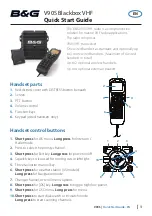
37
Creating a Surround Field in the Main Room
The built-in Surround Processor provides Surround mode and four types of the DSP (Digital Signal Processor) mode —
DAP (Digital Acoustic Processor) mode, 5 CH/4 CH Stereo mode, 3D-PHONIC mode and HEADPHONE DSP mode.
With this receiver, you can use a Surround mode and a DSP mode at the same time. Once you have adjusted Surround
and/or DSP modes, the adjustments done for each source are memorized.
•
You can use “On-screen Menu” for most of the main room operations. For details, see page 50.
The following operations are only possible while the receiver is ready for the main room operations, and are
only used for the main room sources.
DSP modes
With this receiver, you can use four types of the DSP mode.
DAP modes
In order to reproduce a more acoustic sound field in your listening
room while playing music sources, you can use DAP modes. This
mode can be used when the front speakers are connected to this
receiver (without respect to the rear/center speaker connection).
THEATER 1:
Reproduces the sound field of a large theater
(where the seating capacity about 1,000).
THEATER 2:
Reproduces the sound field of a small theater
(where the seating capacity about 300).
HALL 1:
Gives clear vocal and the feeling of a large concert
hall (where the seating capacity about 1,000).
HALL 2:
Gives clear vocal and the feeling of a small concert
hall (where the seating capacity about 300).
LIVE CLUB:
Gives the feeling of a live music club with a low
ceiling.
DANCE CLUB: Gives a throbbing bass beat.
PAVILION:
Gives the spacious feeling of a pavilion with a
high ceiling.
5 CH/4 CH Stereo mode
You can create more powerful sound field for both of the digital and
analog stereo sounds source. The 4 CH Stereo mode reproduces a
sound filed through the front left and right speakers and rear left and
right speakers. The 5 CH Stereo mode adds the center channel
element to the 4 CH Stereo sound field by outputting mixed left and
right signals through the center speaker. This mode cannot be used
when only the front speakers are connected to this receiver
without the rear speakers.
Note:
“5CH STEREO” is selected when setting the center speaker to
“LARGE” or “SMALL.” “4CH STEREO” is selected when setting the
center speaker to “NONE” (see page 29).
Surround modes
With this receiver, you can use two types of the Surround mode.
Following modes cannot be used when only the front speakers
are connected to this receiver (without the rear speakers or
center speaker).
Dolby Surround (Dolby Digital and Dolby Pro Logic)
*
Used to watch the soundtracks of software encoded with Dolby
Digital (bearing the mark
D I G I T A L
) or with Dolby Surround
(bearing the mark
DOLBY SURROUND
).
Dolby Surround encoding format records the left front channel, right
front channel, center channel, and rear channel (total 4 channels)
signals into 2 channels. The Dolby Pro Logic decoder built in this
receiver decode these 2 channel signals into original 4 channel
signals — matrix-based multichannel reproduction, and allows you
to enjoy the realistic sound field in your listening room.
On the other hand, Dolby Digital encoding method (so called a
discrete 5.1 channel digital audio format) records and compresses
the left front channel, right front channel, center channel, left rear
channel, right rear channel, and LFE channel (total 6 channels, but
LFE channel is counted as 0.1 channel, therefore called 5.1
channels) signals digitally. Each channel is completely independent
from other channel signals to avoid interference, therefore, you can
obtain much better sound quality with much stereo and surround
effects.
The Dolby Digital decoder built in this receiver can create much
more realistic sound field in your listening room. You may feel as if
you were in a real theater.
In addition, Dolby Digital enables stereo rear sounds, and sets the
cutoff frequency of the rear treble at 20 kHz, comparing to 7 kHz for
Dolby Pro Logic. These facts enhance the sound movement and
being-there feelings much more than Dolby Pro Logic.
• To enjoy the software encoded with Dolby Digital, you must
connect the source component using the digital terminal on the
rear of this receiver. (See page 10.)
DTS Digital Surround
**
DTS Digital Surround (bearing the mark
) is another discrete
5.1 channel digital audio format available on CD, LD, and DVD
software.
Comparing to Dolby Digital, audio compression rate is relatively
low. This fact allows DTS Digital Surround format to add breadth
and depth to the reproduced sounds. As a result, DTS Digital
Surround features natural, solid and clear sound.
• To enjoy the software encoded with DTS Digital Surround, you
must connect the source component using the digital terminal on
the rear of this receiver. (See page 10.)
*
Manufactured under license from Dolby Laboratories. “Dolby,” “Pro Logic,” and the double-D symbol are trademarks of Dolby Laboratories.
Confidential Unpublished Works. ©1992–1997 Dolby Laboratories, Inc. All rights reserved.
**
Manufactured under license from Digital Theater Systems, Inc. US Pat. No. 5,451,942 and other world-wide patents issues and pending.
“DTS” and “DTS Digital Surround” are trademarks of Digital Theater Systems, Inc. ©1996 Digital Theater Systems, Inc. All rights reserved.
EN37-49.RX-9010VBK[J]f
01.2.15, 0:15 PM
37
















































